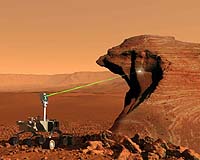 |
Tempe AZ (SPX) Jun 01, 2009 Arizona State University researchers and scientists have created two new features for Google Earth 5.0, the popular online application that lets users tour Earth, the starry sky, and the Red Planet Mars. The first of the new features lets anyone, anywhere, recommend places on Mars to photograph with ASU's THEMIS camera on NASA's Mars Odyssey orbiter. The second new feature shows the most recent infrared images of Mars sent back to Earth from the THEMIS camera. THEMIS is the Thermal Emission Imaging System, a multiband infrared and visual camera designed at ASU by Dr. Philip Christensen. A Regents' Professor of Geological Sciences in the School of Earth and Space Exploration, Christensen is THEMIS' principal investigator and also director of the Mars Space Flight Facility on the Tempe campus. "These two features, developed by our staff in cooperation with programmers at Google, will help everyone have a lot more fun exploring the Red Planet," says Christensen. "It's public engagement at its best."
Hey Mars, Say Cheese! "Using the new feature, people can recommend sites, and these recommendations go to mission scientists who will decide what areas THEMIS images. If a public suggestion matches what the researchers choose, we'll notify the person who suggested the site and let them see the image as soon as we do." To suggest a place for THEMIS to photograph, viewers need two things: Google Earth 5.0 and a file that is updated each week giving the spacecraft's Mars orbital groundtrack. To get the orbital track, users should go to http://suggest.mars.asu.edu and follow the simple steps to register. Registering takes users to a page to download the orbital track file and it also lets them make image suggestions without having to enter an e-mail address with each image suggestion. Registering also creates a customized page where users can see their past image suggestions and find links to their successful ones. With the orbital track file downloaded, viewers start Google Earth and switch the globe to Mars (via the Planets toolbar button, which resembles the planet Saturn). Then viewers open the orbital track file from within Google Earth. Viewers can also just double-click on the orbital file once Google Earth has been set to Mars as its planet. The places where THEMIS can take images during the coming week appear as stripes wrapped onto the Martian globe. Viewers click on stripe segments to recommend places for THEMIS to photograph. "Each viewer can make up to 10 imaging suggestions per week," says Christian Yates, software engineer at the Mars Space Flight Facility. Yates designed the online interface for the project. If a site picked by a member of the public matches one chosen by the mission scientists, the suggester will be sent a link providing access to the image after it has come from the spacecraft. Says Yates, "Making 10 image selections a week, a typical viewer will probably get at least one image." THEMIS takes images at both visual and infrared wavelengths; viewers using Suggest an Image are making recommendations for visual images. These have higher resolutions than THEMIS' infrared ones: 60 feet (18 meters) per pixel versus 330 feet (100 m) per pixel for infrared. "Taking pictures with an orbiting satellite can be a complicated business, but this tool makes it much easier," says Eric Engle, scientific software engineer at the Mars Space Flight Facility and lead project developer for the ASU team. "We hope people enjoy this chance to participate with us in exploring Mars."
Live From Mars When the layer is clicked on, viewers see the Martian globe with the most recent THEMIS infrared images displayed on the surface, each flagged with a square symbol. Viewers can zoom in on each image to see details more clearly. Mousing over the square symbol brings up the image's identification number, and clicking on the symbol opens a bubble window with more information (such as latitude and longitude, and date and time the photo was taken). The bubble also has links to the THEMIS camera site at ASU and NASA's Mars Odyssey site. THEMIS' designer Christensen notes that both new features let the general public look over the shoulder of Mars researchers - and Suggest an Image in particular offers a potentially unique reward: "Because the coverage of Mars by THEMIS at visual wavelengths is by no means complete," Christensen says, "some people who recommend an image target could be the first humans ever to see that particular place in such detail." Share This Article With Planet Earth
Related Links THEMIS Google Earth 5.0 Mars News and Information at MarsDaily.com Lunar Dreams and more
 NASA Selects Student's Entry As New Mars Rover Name
NASA Selects Student's Entry As New Mars Rover NamePasadena CA (SPX) May 28, 2009 NASA's Mars Science Laboratory rover, scheduled for launch in 2011, has a new name, thanks to a sixth-grade student from Kansas. Twelve-year-old Clara Ma from the Sunflower Elementary school in Lenexa submitted the winning entry, "Curiosity." As her prize, Ma wins a trip to NASA's Jet Propulsion Laboratory in Pasadena, Calif., where she will be invited to sign her name directly onto the ... read more |
|
| The content herein, unless otherwise known to be public domain, are Copyright 1995-2009 - SpaceDaily. AFP and UPI Wire Stories are copyright Agence France-Presse and United Press International. ESA Portal Reports are copyright European Space Agency. All NASA sourced material is public domain. Additional copyrights may apply in whole or part to other bona fide parties. Advertising does not imply endorsement,agreement or approval of any opinions, statements or information provided by SpaceDaily on any Web page published or hosted by SpaceDaily. Privacy Statement |